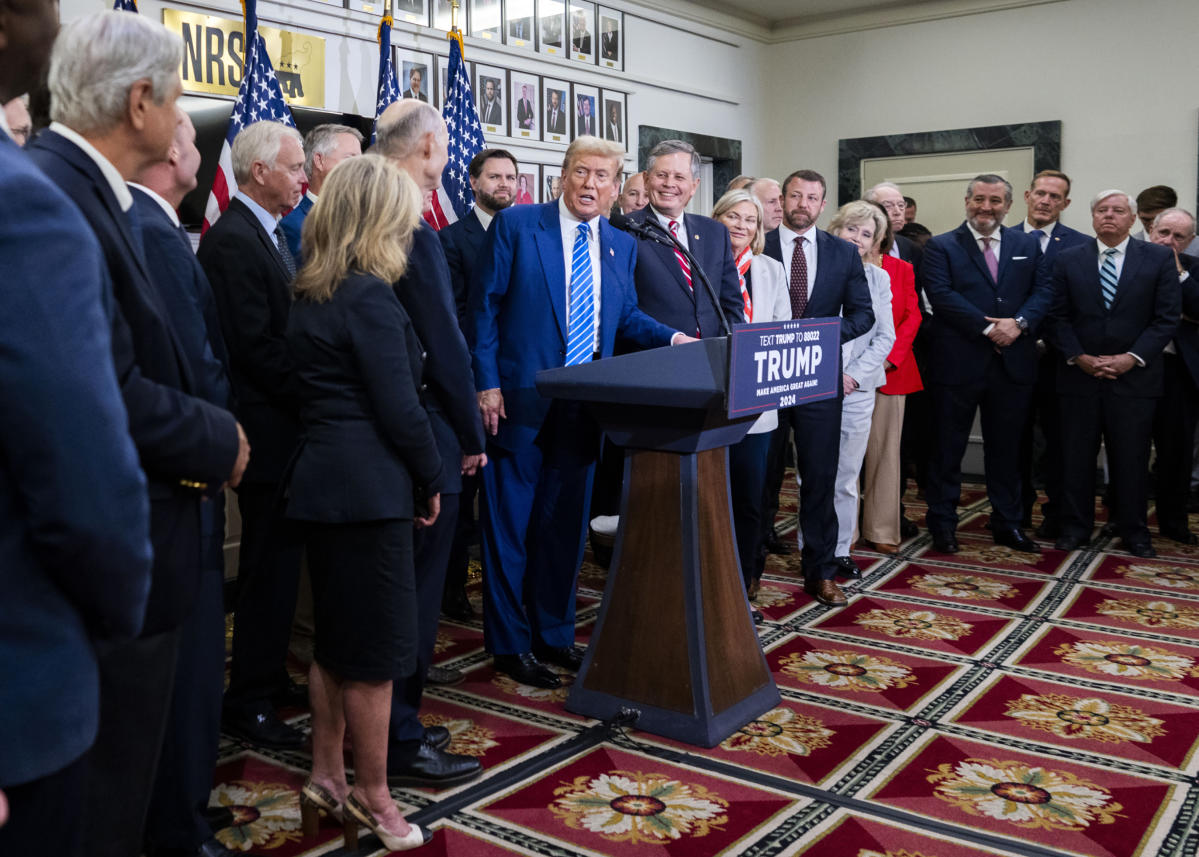For a year now, Drew Weatherford has worked in the shadows across college athletics.
He’s held clandestine meetings with representatives from upwards of 50 Football Bowl Subdivision programs — dozens of athletic directors, a few university presidents, even some school board members and chief financial officers.
There were phone calls from his office, Zoom chats in hotel lobbies and in-person gatherings at coffee shops. Most of them unfold in similar fashion. Gregarious and charming with a sweeping white smile, Weatherford, the former FSU quarterback-turned-private capital investor, presents a slide deck detailing a project that he and co-partner Gerry Cardinale of RedBird Capital Partners launched last year.
Their goal is quite simple: Infuse instant cash into major college athletic departments.
“No school has said, ‘No, that is not something we would consider,’” Weatherford said.
In one of the most consequential weeks in college athletics history, with leaders on the brink of approving a landmark antitrust case settlement and adopting a new revenue-sharing model with athletes, Weatherford is speaking publicly about his exploits for the first time. In two separate meetings with Yahoo Sports, he revealed and then explained the presentation that he showed administrators and university personnel over the last 10-12 months.
Weatherford Capital and RedBird Capital Partners have combined their powers (and billions in cash) to create Collegiate Athletics Solutions, a dedicated campaign and business-building platform for investing capital in college athletic departments at the most transformational time in the industry.
“I had a hunch this revenue sharing thing was real. It is going to be another big blow to athletic departments,” Weatherford said.
College administrators are bracing for the new reality of sharing revenue directly with athletes as part of the terms of the House settlement agreement.
While the NCAA and schools will pay $2.8 billion in back damages, they have also agreed to a future player revenue-sharing model with a quasi-salary cap of as much as $22 million annually per school. Most power conference leaders are expecting to spend as much as $30 million in new revenue annually when considering the revenue-sharing cap, plus a reduction in NCAA distribution for the back damages and the addition of new scholarships in a model that, to some degree, removes financial aid limitations.
That’s $300 million in new money over the duration of the 10-year settlement term. It’s why, over the last two weeks especially, Weatherford’s phone has buzzed more than normal.
This embedded content is not available in your region.
In a timely move last week, RedBird Capital added $4.7 billion to its arsenal for new endeavors, according to the Wall Street Journal, putting the firm at what is believed to be $10 billion in equity.
As part of the Collegiate Athletics Solutions platform, Weatherford and Cardinale are seeking five to 10 programs to invest in as little as $50 million and as much as $200 million. They are in “deep conversations” with a “handful” of programs, though Weatherford declined to identify or discuss specific schools.
At least three power conference school athletic directors confirmed to Yahoo Sports that they have spoken deeply with Weatherford and Cardinale about a partnership. They declined to reveal their identity as the deals have not been finalized.
“If you want to compete at this level, private equity and capital is really important,” one athletic director said. “I’ve been talking to these people for 10-12 months. I haven’t pulled the trigger. But is this what you are going to need to be successful and survive? Yes, it is.”
Private equity and private capital is nothing new to sports.
In fact, RedBird acquired Italian soccer giant AC Milan for $1.3 billion in 2022 and has stakes in Formula One’s Alpine and the Fenway Sports Group, owners of the Boston Red Sox and English soccer team Liverpool. RedBird’s independent content studio, EverWonder, is operating the new in-season, eight-team men’s college basketball tournament based in Las Vegas over Thanksgiving weekend. The tournament is expected to pay participating teams up to $2 million in NIL deals.
These ventures aren’t completely rare in the world of higher education either. But in college athletics, it has been wholly unusual. The words private and equity together spook some. Many scowl at the thought of athletic departments — originally meant to be a university’s non-profit marketing and entertainment entity — giving away control of a portion of itself for fast cash.
Weatherford describes Collegiate Athletics Solutions (CAS) as “private capital,” not equity. There is no ownership here, he says. Schools have the freedom to be flexible with the $50-$200 million lump sum. It is meant to be spent with existing other capitals — think traditional debt, booster donations and bonds — to offset expenses such as athlete revenue sharing, coaching salaries and facilities improvements. But the freedom is theirs.
The CAS project does not require a management role inside the athletic department as private equity often does, he said, though they would aim to be advisors to presidents and athletic directors in managing revenue growth.
After all, they do have an incentive to see increases in a department’s revenue: They earn a percentage on any new annual growth. Over a 10- to 20-year period, that percentage decreases from, perhaps, 22% in the first few years to 2% by its end, as the firm meets its original principal investment. Weatherford describes this as taking a “revenue royalty.”
If there is no growth, the firm does not take a cut.
“They are not mandated to pay us back the money we give them,” Weatherford said.
These capital firms are built around investing wisely in revenue-generating entities. Why take a risk on the unstable situation in college sports if you aren’t guaranteed a profit?
“I deeply personally believe in college athletics,” Weatherford said. “As an ex-athlete, I owe a lot to it and so does my family. We believe in college athletics. I don’t like the fact that 10 to 15 teams have a chance to win a national title every year. I’d like that to be 40-50. It’s not a level playing field. Not everyone has the resources to compete.”
New revenue streams are more important than ever for college athletic departments that, through the years, have saved little to no money in reserves.
Most athletic departments use profit from their one true revenue-generating sport (football) to subsidize the rest of the department. That means funding money-losing Olympic sports and paying for football expenses.
Over the years, fueled by multi-million dollar television contracts, athletic departments at the highest level became flush with cash. Unable to directly compensate athletes and situated in a competitive environment, departments pumped the excess cash into gaudy facility projects and million-dollar coaching and administrative salaries in an effort to compete with their rivals on the recruiting trail.
This result? Many schools are hampered with significant debt that continues to expand as the arms race for facility upgrades and coaching salaries plods onward — until, perhaps, now. Schools will be permitted — not required — to pay athletes directly. The facilities arms race is quickly evolving into one solely focused on compensating athletes.
“Every school that I talk to says they have to max out on revenue sharing or they are no longer going to be competitive and run the risk of being relegated out of their conference,” Weatherford said. “They need to generate more revenue. And the truth is, a lot of their access to capital is strained. They’ve raised a lot of their debt for facilities. They’ve taken on debt, raised gobs of money from donors to build the facilities and I’m not going to say that there is no more room left, but they’re getting to the brink of being exhausted.”
But many still question the need for private equity or capital within college sports. University board members and school presidents, while more warming to the idea, are naturally hesitant. So, too, are the most powerful leaders in the sport.
“What could private equity do that schools can’t with their donors?” asks outgoing American Athletic commissioner Mike Aresco. “Another question … Does private equity align with your goals? I question its role in college athletic departments.”
In an interview last month, SEC commissioner Greg Sankey brushed aside an insinuation that private equity is a savior of sorts for the industry. “If you use the cliché ‘If I was buying stock, I’d buy stock in college sports,’ well, apparently there are a lot of people who believe that outside of college sports,” he said. “Something is going right.”
However, the impending revenue-sharing model has administrators searching for cash. The new model is expected to take effect starting next academic year, in the fall of 2025. Fourteen months to come up with upwards of $30 million isn’t easy.
For those in the Big Ten and SEC, the task isn’t as difficult. Over the next few years, more than $25 million in new television and College Football Playoff monies are on the way for each of those members.
In the ACC and Big 12, things are more tricky.
In fact, one ACC school may be further along than others in the hunt for private money. Florida State and athletic director Michael Alford are believed to be seriously exploring such a path, with multi-million dollars in figures emerging from public records obtained by Sportico and the Tampa Bay Times.
While Weatherford sits on the FSU Board of Trustees, he is not involved with the Seminoles’ private equity venture, he said. However, perhaps in the not-too-distant future, Collegiate Athletics Solutions, or some other entity, will cut a giant check to an athletic department near you.
“It’s basically like going and taking out a loan and repaying it over 15-20 years,” said another power conference athletic director. “Here’s the thing: How desperate are you? Because you’ve got to pay off that note.”

Daniel Miller is a sports fanatic who lives and breathes athletics. His coverage spans from major league championships to local sports events, delivering up-to-the-minute updates and in-depth analysis for sports enthusiasts.






